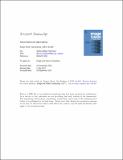Files in this item
Texture features for object salience
Item metadata
| dc.contributor.author | Terzić, Kasim | |
| dc.contributor.author | Krishna, Sai | |
| dc.contributor.author | du Buf, J. M. H. | |
| dc.date.accessioned | 2018-09-24T11:50:19Z | |
| dc.date.available | 2018-09-24T11:50:19Z | |
| dc.date.issued | 2017-11 | |
| dc.identifier | 251156304 | |
| dc.identifier | b8be4adf-c928-48f1-825d-8a057802ead7 | |
| dc.identifier | 85030120053 | |
| dc.identifier | 000414883800004 | |
| dc.identifier.citation | Terzić , K , Krishna , S & du Buf , J M H 2017 , ' Texture features for object salience ' , Image and Vision Computing , vol. 67 , pp. 43-51 . https://doi.org/10.1016/j.imavis.2017.09.007 | en |
| dc.identifier.issn | 0262-8856 | |
| dc.identifier.other | RIS: urn:1243F430D324487204F764B736DA6829 | |
| dc.identifier.uri | https://hdl.handle.net/10023/16065 | |
| dc.description | This work was supported by the EU under the FP-7 grant ICT-2009.2.1-270247 NeuralDynamics and by the FCT under the grants LarSYS UID/EEA/50009/2013 and SparseCoding EXPL/EEI-SII/1982/2013. | en |
| dc.description.abstract | Although texture is important for many vision-related tasks, it is not used in most salience models. As a consequence, there are images where all existing salience algorithms fail. We introduce a novel set of texture features built on top of a fast model of complex cells in striate cortex, i.e., visual area V1. The texture at each position is characterised by the two-dimensional local power spectrum obtained from Gabor filters which are tuned to many scales and orientations. We then apply a parametric model and describe the local spectrum by the combination of two one-dimensional Gaussian approximations: the scale and orientation distributions. The scale distribution indicates whether the texture has a dominant frequency and what frequency it is. Likewise, the orientation distribution attests the degree of anisotropy. We evaluate the features in combination with the state-of-the-art VOCUS2 salience algorithm. We found that using our novel texture features in addition to colour improves AUC by 3.8% on the PASCAL-S dataset when compared to the colour-only baseline, and by 62% on a novel texture-based dataset. | |
| dc.format.extent | 1801433 | |
| dc.language.iso | eng | |
| dc.relation.ispartof | Image and Vision Computing | en |
| dc.subject | Texture | en |
| dc.subject | Colour | en |
| dc.subject | Salience | en |
| dc.subject | Attention | en |
| dc.subject | Benchmark | en |
| dc.subject | QA75 Electronic computers. Computer science | en |
| dc.subject | NDAS | en |
| dc.subject.lcc | QA75 | en |
| dc.title | Texture features for object salience | en |
| dc.type | Journal article | en |
| dc.contributor.institution | University of St Andrews. School of Computer Science | en |
| dc.identifier.doi | 10.1016/j.imavis.2017.09.007 | |
| dc.description.status | Peer reviewed | en |
| dc.date.embargoedUntil | 2018-09-22 |
This item appears in the following Collection(s)
Items in the St Andrews Research Repository are protected by copyright, with all rights reserved, unless otherwise indicated.

